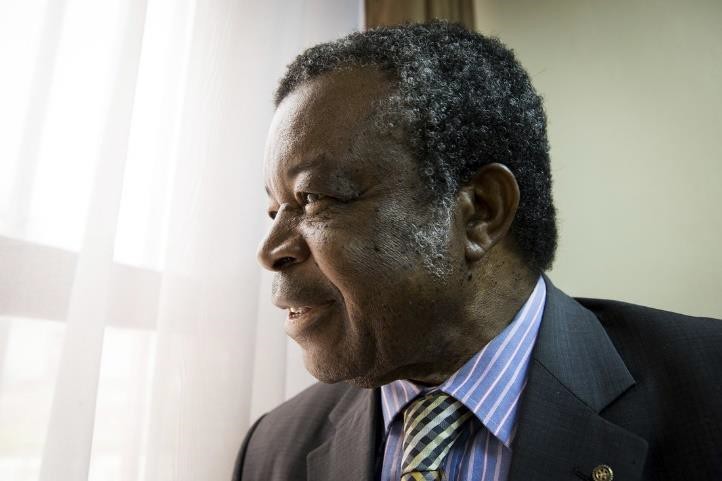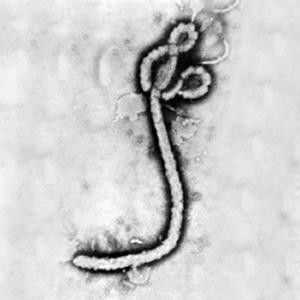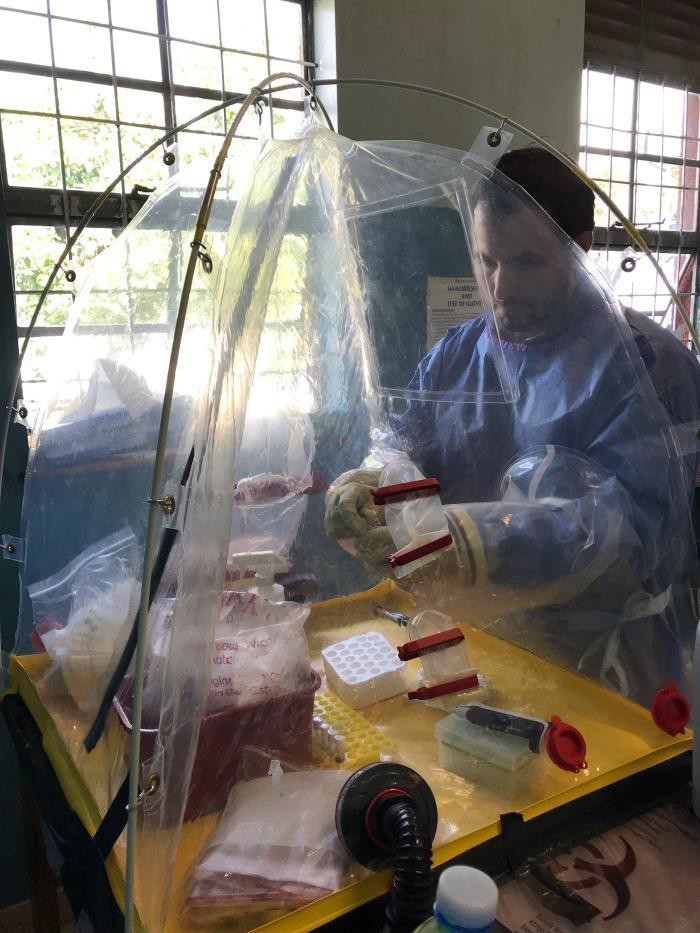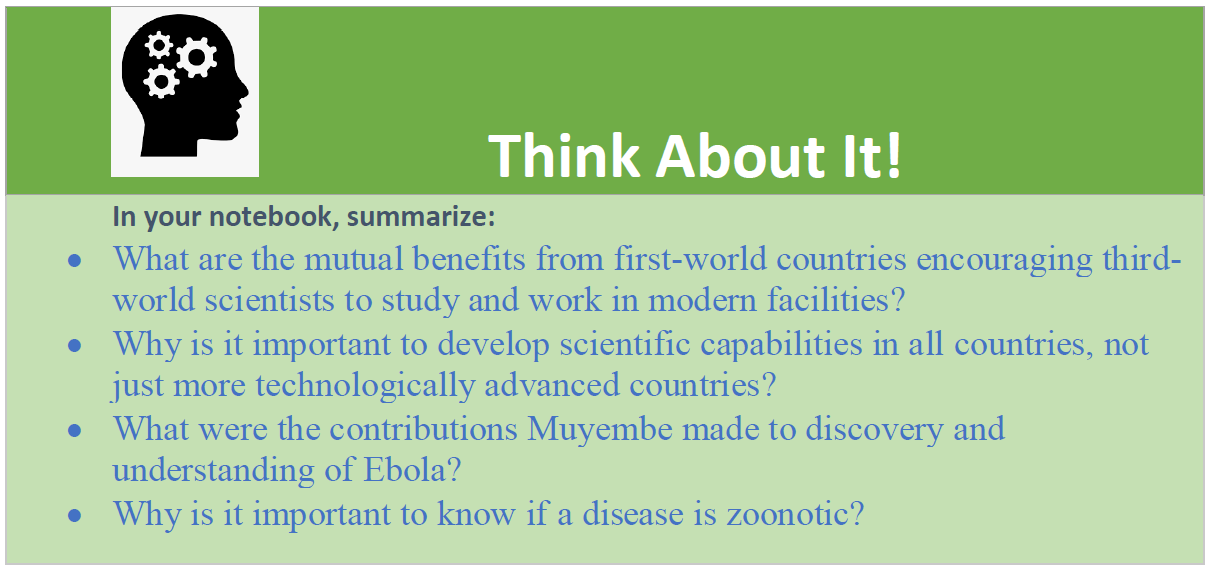Rachael Guterrez, 7th grade student, with furrowed brow, raises her hand, and asks: “Ms. Rainey, whenever I am real sick, the doctor usually wants a blood sample. Drawing blood hurts. Why is that thought to be necessary?”
Ms. Rainey replies, “Well, Rachael, a blood sample can be analyzed for abnormal changes in red and white blood cells, plus a wide variety of chemicals normally found in blood. Changes may indicate disease. In the case of infectious diseases, microscopic examination can help reveal blood parasites, bacteria, and viruses.
 Viruses, such as Ebola that we are concerned with in this biography, are extremely small, but they have distinctive structure that helps to identify them if their image is greatly magnified by electron microscopy. They can also be extracted from blood and their gene sequence determined. This is useful for developing vaccine strategies.
Viruses, such as Ebola that we are concerned with in this biography, are extremely small, but they have distinctive structure that helps to identify them if their image is greatly magnified by electron microscopy. They can also be extracted from blood and their gene sequence determined. This is useful for developing vaccine strategies.
Meet the Scientist,
Jean-Jacques Muyembe
1947-Present

Dr. Jean-Jacques Muyembe, was the first to recognize the “new” zoonotic disease, Ebola, in 1973. Many years passed before he finally got credit for the discovery, which was delayed because an international team of researchers was involved in the early research.
Born in Africa, Jean-Jeacques was the child of farmers. He was educated in church schools run by Jesuits. He studied medicine, starting in 1962, at the Lovanium University in the Belgian Congo (Democratic Republic of the Congo) where he became interested in microbiology and graduated in 1969. He earned a Ph.D. in virology at the University of Leuven in Belgium, working on viral infections using mice as research animals. He could have stayed in Europe, but in 1973 he decided to return to Congo, known then as Zaire, which had only recently attained independence from Belgium.
One reason he returned to his home country was that if he had stayed in Belgium, he would have been doing routine lab work. But in Congo, he would be responsible for the “health of my people.” However, in the Congo, research facilities were primitive. He had no lab and no mice to use in experimentation. As a result, he took a job as a field epidemiologist. In 1976, he was called to investigate an outbreak of a mysterious disease in central Congo. This “new” disease was killing many people, and the symptoms resembled those of other diseases common in the area, such as yellow fever, typhoid or malaria. Since these other diseases were common and well-studied, it was easy to misdiagnose Ebola.
One symptom that flagged this disease as something new was that when routine blood samples were taken, the puncture site gushed with blood. Something was disturbing the normal clotting mechanisms that did not occur with the diseases that were otherwise similar. Also, the Belgian nuns working in the Congo had been vaccinated for Yellow Fever, making that disease an unlikely cause. He sent a blood sample from one of the nuns with this unknown disease to an electron microscope lab in Belgium, and their analysis revealed this to be an unknown virus.
Because patients bled excessively and had fevers, the disease was called “hemorrhagic fever.” It was soon renamed “Ebola,” the name of a river near a village with a large outbreak.

virus. Source: UTMB, Galveston
Muyembe’s role in recognizing this as a new disease was quickly overlooked. Credit for discovery went to scientists outside of Africa who studied blood samples that Muyembe sent them. The electron microscopy images revealed the blood to contain a snakelike filament — huge in comparison to other viruses and very similar to the Marburg virus. In 1976, the virus was simultaneously studied in Antwerp, Belgium, in Porton Down, United Kingdom and in Atlanta, Georgia.
People in Belgium, England, and the U.S. wanted to take credit. White scientists outside of Africa flew into Africa, took samples, wrote papers that were published in the West, and took the credit. Meanwhile, Muyembe was recognized as a national hero in the Congo. He was the first to recognize the uniqueness of Ebola and spared the world the disaster of misdiagnosis. This was a new disease that called for new treatment and prevention measures.
Muyembe was the first to identify the animal source of Ebola, which was African fruit bats. Like many zoonotic diseases, certain animal species act as a reservoir of infectious agents that humans can contract when they move into wild animal habitats. He also pioneered in the treatment of Ebola and other virus diseases with antibodies taken from surviving patients. In another outbreak in 1995, he tested the idea that antibodies developed by Ebola survivors could be extracted from their blood and used to treat new cases. The treatment worked, with seven of eight patients surviving this otherwise highly fatal disease that kills some 81% of infected people. This antibody treatment was a forerunner of the current use of an antibody medication being used today in the treatment of the COVID-19 coronavirus pandemic.

In recognition of the global nature of disease, scientific resources from outside countries have been brought to Africa. Congo researchers now have sophisticated labs and mice to help them in their research on Ebola and other zoonotic diseases.
Perhaps most significantly, the Ebola outbreaks in Africa call attention to the fact that zoonotic diseases are becoming more common as people intrude into wildlife environments where animals harbor diseases that can infect humans. Professor Muyembe warned that increasing human intrusion into wild environments, we will be exposed to animals carrying diseases. Humans also expose themselves to zoonotic diseases when they use wild animals as a food source. Often these creatures, like bats and rats, survive their zoonotic diseases and eventually pass infections on to us. The professor’s prophecy has come true with the COVID-19 pandemic that apparently arose from wild animals in China. We have entered a new and dangerous era of disease.

Sources:
- https://www.cdc.gov/ncezid/stories-features/global-stories/ebola-reservoir-study.html
- https://www.nationalgeographic.com/science/health-and-human-body/human-diseases/ebola-virus/
- https://www.npr.org/sections/goatsandsoda/2019/11/04/774863495/this-congolese-doctor-discovered-ebola-but-never-got-credit-for-it-until-now
- “Discovery and Description of Ebola Zaire Virus in 1976 and Relevance to the West African Epidemic During 2013–2016”. Journal of Infectious Diseases. 214 (suppl 3): S93–S101. doi:10.1093/infdis/jiw207.
- https://metro.co.uk/2020/12/23/scientist-who-discovered-ebola-in-70s-has-warning-on-future-pandemics-13797977/?ito=cbshare
Author: W. R. Klemm
Test Yourself

Time's up
